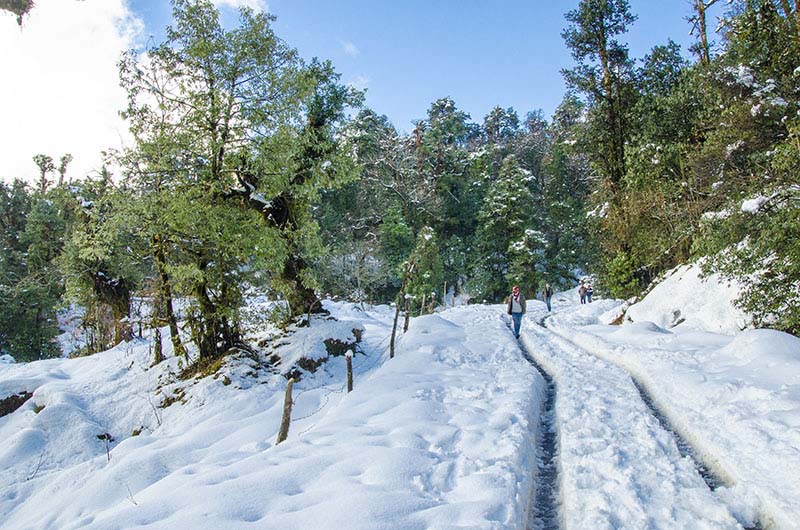Nestled in the picturesque Garhwal region, Chopta and Tungnath beckon adventure enthusiasts with their serene beauty, especially during the winter months. As the snow blankets the landscape, embarking on a winter trek to these enchanting destinations requires meticulous planning. This guide aims to provide a detailed overview of the essentials, safety measures, and the cultural richness of the region, ensuring a rewarding winter trekking experience.
Preparing for the Journey
Essential Gear and Clothing
- Insulated Layers: Bundle up with thermal wear, fleece jackets, and down-filled outer layers to combat the biting cold.
- Waterproof Boots: Invest in sturdy, waterproof boots to navigate through snow-covered trails.
- Cold-Weather Accessories: Don't forget essentials like gloves, hats, and goggles for protection against frosty winds.
Fitness and Health Considerations
- Physical Fitness: Build stamina and strength through regular exercise, preparing your body for the challenging trek.
- Altitude Acclimatization: Gradual ascent and acclimatization stops are crucial to prevent altitude-related issues.
Weather Conditions
Understanding Winter Weather in Chopta
- Temperature Fluctuations: Be prepared for extreme temperature variations, ranging from chilly mornings to freezing nights.
- Snowfall Patterns: Familiarize yourself with the region's snowfall patterns to anticipate trail conditions.
Best Time for Winter Trekking
Plan your trek during the winter months, typically from December to February, when the landscape transforms into a winter wonderland.
Route Planning
Choosing the Right Trekking Route
- Chopta to Tungnath: Explore the scenic route from Chopta to Tungnath, known for its breathtaking vistas.
- Altitude Gain and Difficulty Levels: Understand the elevation gain and difficulty levels to choose a trek that suits your skill and experience.
Navigation Tips
- Maps and GPS: Carry detailed maps and a reliable GPS device for accurate navigation.
- Landmarks and Signposts: Look for landmarks and signposts to stay on the right path.
Accommodation
Options for Shelter
- Tents: Experience the thrill of camping in the snow, surrounded by nature.
- Guesthouses and Lodges: Explore cozy guesthouses and lodges for a comfortable stay.
- Hotels: Book hotel services in Chopta in advance for a more luxurious and structured accommodation experience.
- Homestays: Immerse yourself in the local culture by opting for homestays, offering a more personalized and authentic stay with the warmth of local hospitality.
(Secure your accommodation in advance, especially during peak winter trekking season.)
Safety Measures
Emergency Protocols
- Communication Devices: Carry communication devices like a satellite phone for emergencies.
- First Aid Kit: Pack a well-equipped first aid kit for minor injuries and ailments.
Dealing with Harsh Conditions
- Frostbite Prevention: Learn and implement frostbite prevention techniques.
- Snowblindness Awareness: Protect your eyes from snowblindness with UV-protective goggles.
Flora and Fauna
Winter Ecosystem in Chopta
- Indigenous Wildlife: Encounter the diverse wildlife of the region.
- Unique Plant Species: Explore the resilience of unique plant species adapted to the winter climate.
Local Culture and Customs
Respecting the Indigenous Communities
- Cultural Sensitivity: Respect local customs and traditions.
- Interaction Etiquette: Interact with locals respectfully, learning about their way of life.
Leave No Trace Principles
- Waste Management: Follow Leave No Trace principles for eco-friendly trekking.
- Eco-Friendly Camping: Minimize environmental impact by choosing eco-friendly camping practices.
Budgeting for the Trek
Cost Breakdown
- Permits and Entry Fees: Budget for necessary permits and entry fees.
- Equipment Rental Options: Explore cost-effective equipment rental options.
Post-Trek Recovery
Taking Care of Yourself
- Rest and Recovery: Prioritize rest and recovery post-trek.
- Trek Health Check: Monitor your health after the trek, seeking medical attention if needed.
Connecting with Fellow Trekkers
Building a Trekking Community
- Online Forums and Groups: Join online communities to share experiences and gather valuable insights.
- Networking during the Trek: Forge connections with fellow trekkers for a richer experience.
Chopta and Tungnath: Beyond Winter
Other Seasons and Activities
- Spring and Summer Treks: Explore the region's beauty in different seasons.
- Local Festivals and Events: Immerse yourself in the local culture by participating in festivals and events.
Summary
So, planning a winter trek to Chopta and Tungnath? It's all about enjoying the snowy adventure! Get the right gear, be ready for fun, and choose where to stay – camping, hotels, or cozy homestays. Remember, stay safe, learn about local ways, and make lots of cool memories in this amazing winter wonderland. Ready for the journey? Let's go!



Comments